One of our favorite tips on getting more value out of social media:
Share your blog posts and articles more than once.
We’ve come up with a sharing schedule for every new blog post that publishes on the Buffer blog—sharing the post when it publishes, later the same day, the next day, later in the week, and on and on into the future. And in doing so, we’ve come across some really interesting pearls of wisdom.
There are some headlines that just keep collecting clicks no matter how many times we tweet them.
I’d love to share with you what these headlines are, what makes them so effective, and how (and why) we’ve built a process to keep sharing this content that our audience finds valuable. We’d love to hear any thoughts this brings up for you!
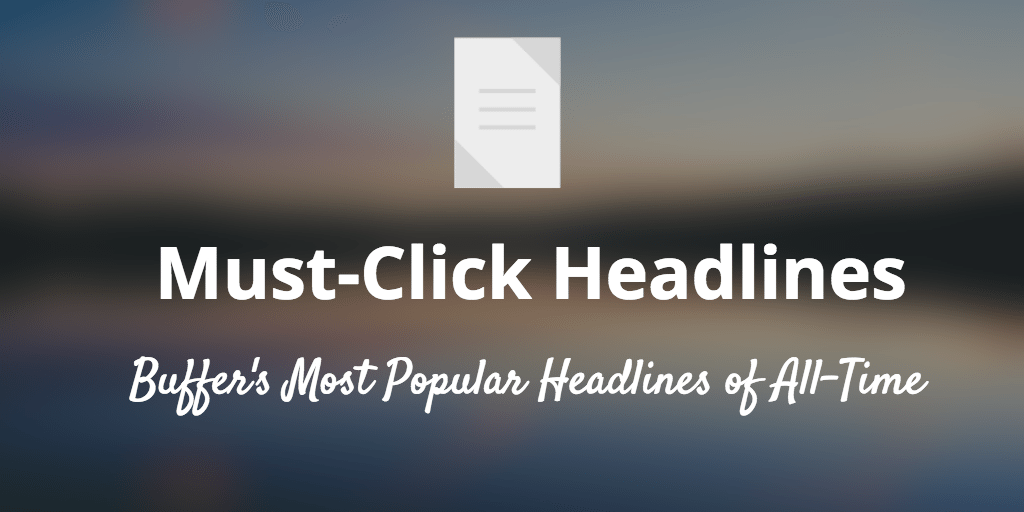
10 Eternally Clickable Headlines of Buffer
Here’s a selection from our go-to list of social media posts that we share to Twitter:
- Twitter Tips for Beginners: Everything I Wish I Knew When I Started
- How I Got 4x Faster Writing Blogposts
- The Origin of the 8-Hour Work Day and Why We Should Rethink It
- 59 Free Twitter Tools and Apps That Do Pretty Much Everything
- Shave 20 Hours Off Your Work Week With This Email Template
- How to Get Your First 1,000 Followers on Twitter — A step-by-step guide!
- 30 Little-Known Features of the #SocialMedia Sites You Use Every Day
- How to Easily Save 60 Minutes Every Day on the Internet
- 7 Ways I Accidentally Got More Twitter Followers (and How You Can on Purpose!)
- 53+ Free Image Sources For Your Blog and Social Media Posts
Our tweets average 100 to 150 clicks each. These headlines? They routinely pull in 200+ clicks every time we share them.
Here’s a peek at the Twitter Tips for Beginners headline, shared in the past 90 days.
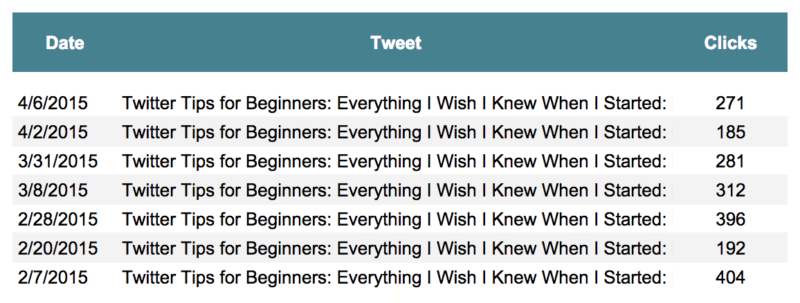
What makes these headlines great?
There’s a lot that goes into a clickable, shareworthy headline—things like formulas and psychology and science.
We’ve written before about the psychological reasons why some headlines grab readers tighter than others.
We’ve written about headline formulas where you can plug-and-play with different words and orders.
We’ve found the most popular words and the most viral content.
And given all this research and insight, we’ve been grateful for the chance to try it all out and build a few headlines that lots of people love. Here’s what we think might be at work behind the eternally clickable headlines in the above list.
1. An aspirational theme
What’s one thing that all these headlines have in common? They’re about working smarter and less!
And a lot of people seem to be interested in those topics. (For very understandable reasons!)
Sure, to a certain degree, the aspirational tone of a headline somewhat relates to the type of content you’re publishing and sharing. Aspirational headlines come a bit easier for certain topics like life-hacking or productivity, for instance.
That being said, I think any industry or niche can come up with improvement-focused headlines like these if the content is framed appropriately.
Take, for example, some of the aspirational headlines in our list (about topics like social media and email that aren’t necessarily thought of as aspirational):
- Shave 20 Hours Off Your Work Week With This Email Template
- How I Got 4x Faster Writing Blog Posts
- How to Get Your First 1,000 Followers / Get More Followers
They share a common theme of efficiency and time-saving. Now, how might you put these thoughts into action if you were to, say, be blogging about classroom education? Perhaps:
- The 5 Hacks That Help Me Grade Papers and Still Have Time for Netflix
- How I Got 4x Faster Writing Lesson Plans
- A Step-by-Step Guide to Helping Your Most Challenging Students Shine
2. Psychological learnings
In Courtney’s post about the psychology of headlines, she listed eight different headline types that might affect a person’s reaction and emotion.
- Surprise
- Questions
- Curiosity
- Negatives
- “How to”
- Numbers
- Audience Referencing (e.g., “You”)
- Specificity
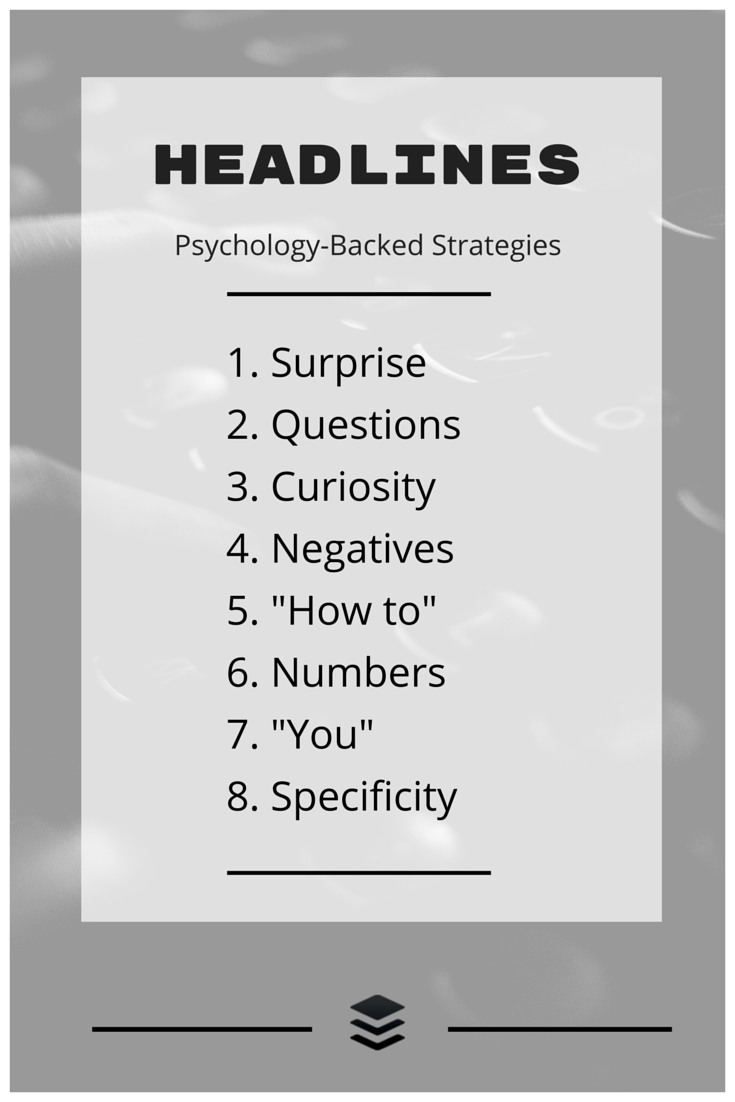
The psychological factors that are evident in our most clickable headlines are
- How to
- Numbers
- Audience Referencing, and
- Specificity
Four of the 10 headlines use the word “how.” (The post you’re reading now includes “How” also!)
Nine of the 10 include numbers.
Five of the 10 use a form of the word “You.”
And specificity is apparent in the headlines like “save 60 minutes” (instead of the broader “an hour”) and “got 4x faster.”
(Sidenote: A few of the other psychological headline types on this list we choose to avoid, perhaps due to our blog’s voice and tone or based on experience. Questions, for example, is one we seldom use, perhaps based a bit on Betteridge’s Law of Headlines, which states: “Any headline that ends in a question mark can be answered by the word no.”)
3. Smooth-sounding formula
As part of our idea process, we sometimes come up with articles based solely on a headline that sounds really cool. (We did this with the Delightfully Short Guide to Social Media ROI, which was borne from Zen Habits’s The Delightfully Short Guide to Reading More Books.)
Some headlines just seem destined for clicks.
This is the case with a few of the eternally clickable headlines on the list. And if you break it down far enough, you’ll see that a lot of these great headlines are based on a formula.
______ for Beginners
Everything I Wish I Knew About ____ When I Started
The Origin of the _________
How to Get Your First ________
Little-Known Secrets of _______
There’re tons more headline formulas that have been proven to work
4. Targeted for our audience
We benefit greatly from being a social media blog that shares our content on social media. There’s a built-in interest already there for a large majority of our content.
Looking at some of the top headlines here, four of them reference Twitter.
Makes sense that the Twitter audience would find these relevant and click-worthy.
So what might you take away from this if you aren’t writing about Twitter tips and strategies (which I assume is a good portion of you)? I think there’s still something to be said for targeting your audience’s interests, problems, and needs.
For instance, we know that the Buffer community is super interested in ways to work smarter. So we have a pretty good feeling about headlines that tell you how to save time online.
Can you think of similar passions for your audience?
How We Find Our Best-Performing Headlines
Inside Buffer’s new sortable analytics
One of my favorite ways to optimize the social media marketing we do at Buffer (and to keep our Buffer queue full) is to discover the posts that have done best in the past.
And there’s a super easy way to do this in the Buffer dashboard.
Using the new sortable analytics, I can sort all the posts that have been shared to the Buffer queues, sorting by metrics like clicks and retweets, then filtering by date (past 7 days, past 30 days, or even a custom timeframe).
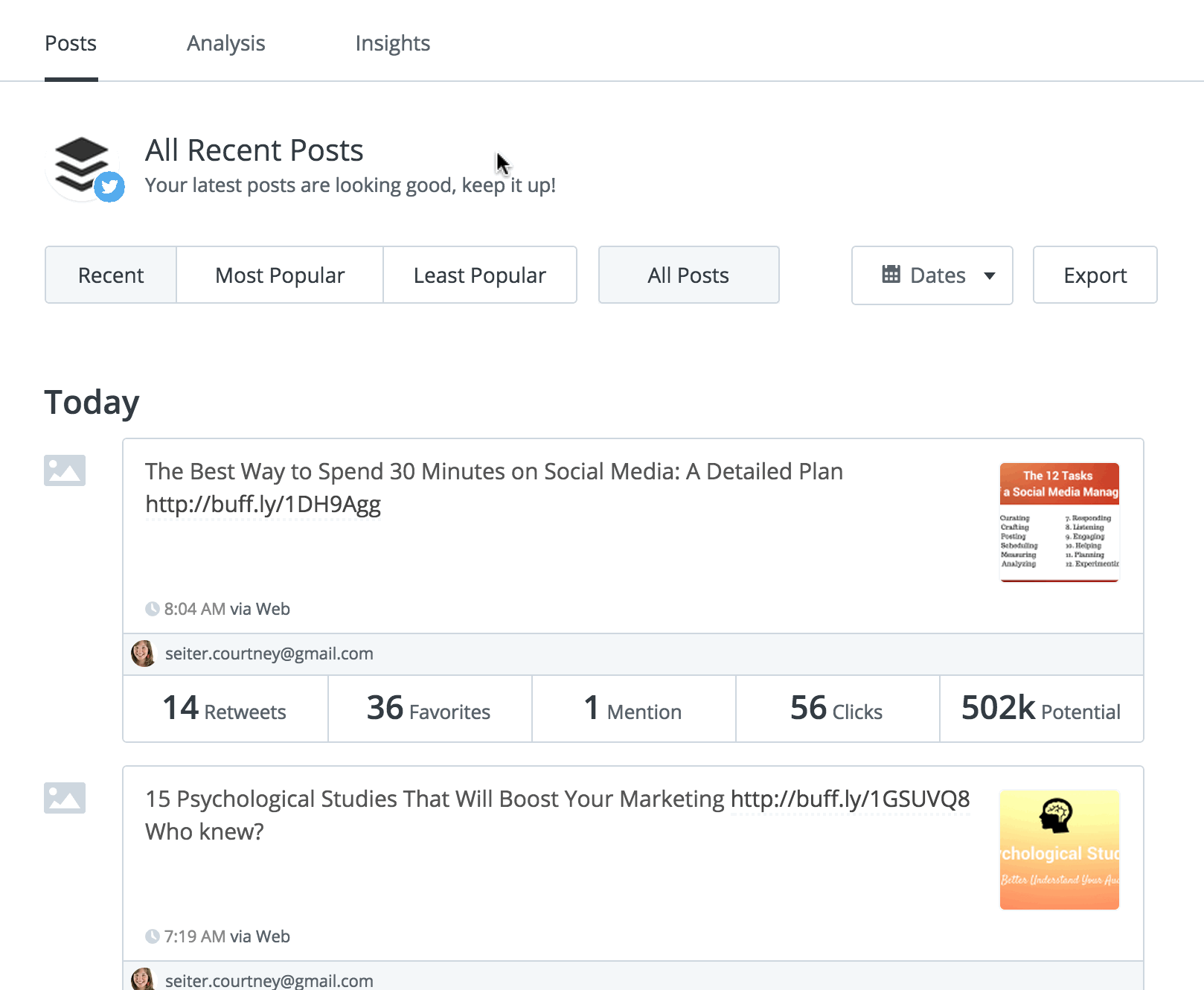
When I do this for the past 30 days, here are the top results that I get:
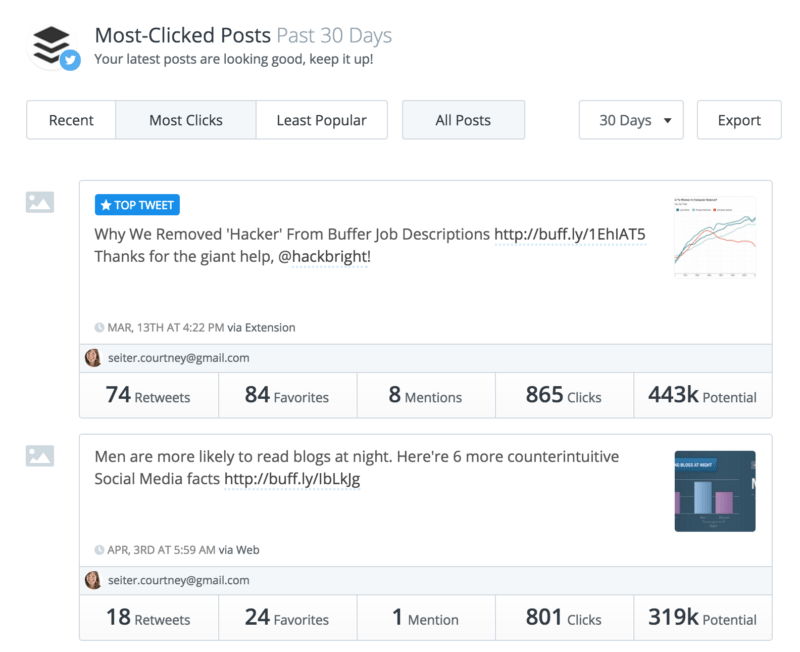
(It’s also super easy to click to re-buffer these top-performing posts, tweak them, and share them again.)
Why we share the same blog post multiple times
Reposting your best content to social media is a strategy that we’ve been following for quite some time now. It’s one that big brands like Moz use and recommend.
And though I help with this strategy in sharing to Buffer, I still find myself needing a reminder to implement this with my personal brand. There’re so many great reasons why. Here are the big three.
1. Reach people who did not see your tweet the first time.
Each tweet is only seen by a small percentage of your followers—in some cases, a super small percentage.
At Buffer, 4 percent of our followers (12,000 out of 300,000) see any given tweet.
(And this percentage is likely inflated by the impressions from other people retweeting a tweet.)
That leaves 288,000 people who did not see a Buffer tweet the first time we sent it out. Potentially, we could send the same exact tweet 25 times without anyone seeing it twice.
2. Reach your new followers
By the time you’ve tweeted out something to your followers, you very well may have gained new ones—new ones with little to no prior history of what you’ve shared before.
For instance, we average about 450 new followers each day on the Buffer Twitter account. In one week’s time, that’s 3,150 new people who might be interested in content we’ve shared in the past.
3. Reach followers in multiple time zones
Guy Kawasaki has a great quote about the time zone rationale (it works for people with varying social media habits, too, like a couple of San Francisco-based followers who check Twitter at different times of day).
We provide content repeatedly because people live in different time zones and have different social media habits.
Followerwonk is a great tool for finding out the geographic location of your Twitter following. Here’s what the map looks like for my personal account. It’s quite spread out, similar to that of Buffer’s, which is why we tend to share on a 24/7 social media schedule.
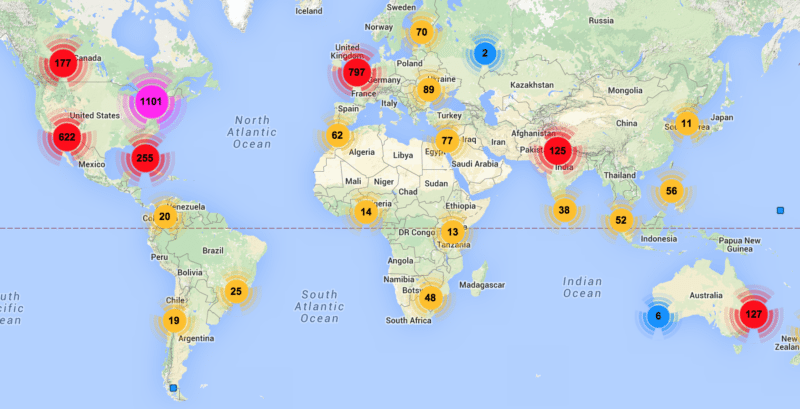
I’d love to ask: How does this resharing feel to you, as a member of the audience? I’m keen to understand things fully from your perspective, too, on whether or not this feels too self-promotional or out of line with what you picture in a social media strategy.
Takeaways
Thanks for letting us share a bit about some of our most click-worthy Twitter headlines. It’s been neat to see the kind of response that these posts get. What it seems they have in common:
- Aspirational tone or message (“work smarter and save time!”)
- How to, Numbers, “You,” and Specifics
- Tried-and-true headline formula
- Catered to the interests, problems, and needs of our audience
I hope you can find some inspiration here for any headline experiments you’re eager to try.
What do you notice from this list of click-worthy headlines? What stands out? I’d love to hear your thoughts in the comments.
Image sources: Pablo, IconFinder, Unsplash, Death to the Stock Photo
Try Buffer for free
190,000+ creators, small businesses, and marketers use Buffer to grow their audiences every month.


